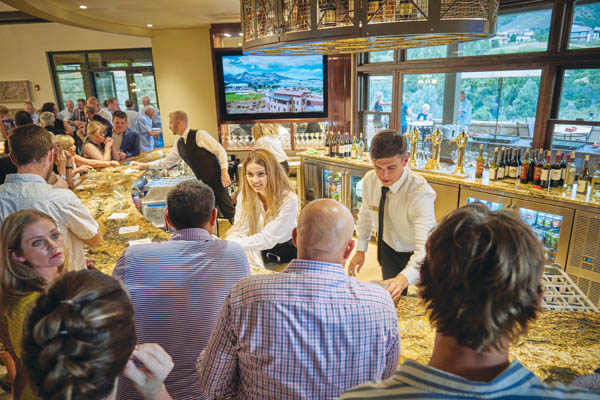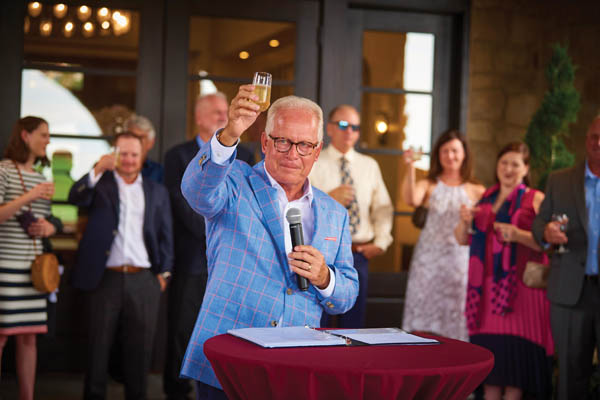2025 Colorado Getaways: Steamboat Springs
Steamboat Springs is like a secret only you and your friends know
By Jon Rizzi

The tent has finally come down. For 17 years, the huge, white “temporary structure” served as The Club at Ravenna’s nerve center, complete with a kitchen, dining area, bathrooms, patios, sales office and golf shop.
Yet for all its functionality, the ersatz clubhouse was also a totem of unfinished business, the residue of a history tainted by a Great Recession-prompted bankruptcy and a club without a permanent physical home.
As recently as 2018, members would gather in the tent before and after rounds on Ravenna’s robust Jay Morrish-designed course. Many arrived in personal golf cars from multimillion-dollar homes tucked into the sandstone outcroppings of the surrounding enclave. Invariably, someone would ask some variation of “What’s happening with the clubhouse?”
“I am so glad I’ll never have to answer that question again,” the club’s owner and CEO Kevin Collins says with noticeable relief.

The softspoken Collins, who took ownership of the club in 2015 and has engineered its remarkable resurgence, sits in the high-ceilinged men’s grill in Villa Ravenna—the spectacular 25,000-square-foot clubhouse that opened at the end of July. Sunlight streams through multiple windows as soothing guitar sounds waft through the room. Near the brightly lit bar, a muted 100-inch TV splits the morning news into four separate screens. Dark wood-grained wallpaper and Tudor-style half-timbering suggest an English manor, but in place of a trophy stag above the entrance, a 19th-century bronze fresco from an Argentine polo club hangs above the exit to the adjoining patio and firepit.
Villa Ravenna, Collins explains, represents the latest effort in fortifying Ravenna’s brand. The others include improving the golf course by halving the number of bunkers and tempering the greens; installing Toptracer units on the driving range; hiring Chef de Cuisine David Lazarus, whose pedigree includes stretches at The Broadmoor, Castle Pines and Denver Country Club; and building La Bella Vita, a resort-like 11,000-square-foot fitness and wellness facility that opened in 2018 and features state-of-the-art cardio and fitness equipment, trainers, a full-time physical therapist and an outdoor pool with cabanas and food service.
At the time Collins was building La Vita Bella, he brought in 300,000 cubic yards of dirt to create the site for Villa Ravenna. Soon came the pandemic —and with it with spikes in rounds, membership sales and homesite purchases. Between 2020 and 2021, 149 new members joined, and all 234 lots had sold. With financing in place and members agreeing to make a modest contribution, Collins had the foundation poured on the new clubhouse in August of 2020, brought in the steel and went vertical the following May.
Seventeen months and $15 million later, here we are.

Suggesting a fortified Italian town, Villa Ravenna perches atop a hill at the end of a climbing, winding road. A tower with backlit clockface adds an Old-World touch, while modern conveniences like a heated driveway and skylit port-cochere with piped-in music create ambience. There’s a covered bag drop, but Collins nixed valet parking. “I don’t want a teenager parking a Lamborghini,” he says. “The lot’s close, and, if needed, someone with a golf cart will get you.”
A warm, buttery hue covers the walls of the entry hall—as well as the teardrop speakers hung from the ceiling—and flows into the adjacent bar and dining area. Illuminated mainly by an iron chandelier, this main foyer includes a plush lounge area to handle overflow from the bar. Gnarled wood frames the doors and windows and creates a ribbon of crown molding midway around the perimeter.
The décor throughout blends antique items—some centuries old— and commissioned artwork by master painter André Martinez, who spent 18 months on the projects. Among his featured pieces are an oil of a communal Ravenna streetscape and a stylized cartograph of the ancient city cut into 12 framed units. Painted on lime plaster, large frescoes depicting the four prophets from the Sistine Chapel join members in the dining area.
And those members have been coming in droves.
“We had 120 people on a Tuesday night and another 120 the next night,” Collins says, noting the tent used to draw about 10 or 15. “We’re going to limit it to 50 reservations for a while, so the kitchen doesn’t get overwhelmed—and I don’t want people to be upset.”
If they are, Collins wants to hear about it. Ravenna doesn’t have a board or committees. “It’s a benevolent dictatorship,” Collins explains. “It’s not about ego; it’s about efficiency. If people have an issue, they can come and talk to us. If it makes sense to change what we’re doing, we’ll look into it.” As he walks through the impeccably appointed building, the positive reactions he gets from members and staff leave little doubt as to the effectiveness of his approach.
They’re grateful to have a clubhouse, yes, but it’s more than that. It’s the no-expense-spared quality of that clubhouse: the attention paid to the amenities in the women’ locker room and lounge; the detailed brickwork of the intimate wine cave at the base of a spiral staircase from the dining area; the 1,660-bottle wine cellar’s custom glass-and-tile mosaic that mirrors one from 6th Century Ravenna; the 3-foot-high tempered glass panels that protect patio patrons from hosel rockets launched at the 18th green; and the puck-sized speakers attached to those panels, transforming each one into a rectangle of resonance.
“We designed the clubhouse with a vision that our membership was not going to be significantly large,” Collins explains. “We wanted to have more of boutique club, where we could provide a great experience for our members.” Their numbers currently stand at about 350, which is 45 below Ravenna’s self-imposed cap.
La Vita Bella, Villa Ravenna and Il Corso di Golf can certainly accommodate that increase. With $65,000 initiation and a stunning 25,000-squarefoot sales tool, it shouldn’t be too hard to get there. Collins is already eyeing other member-experience enhancements and has recently received approval to develop another 10 lots near the development’s gatehouse, bringing the 634-acre development right up to its 250-home limit.
“It was never a foregone conclusion that we were going to be successful,” Collins says, recounting some of the less pleasant situations of the last seven years. Crediting the staff for its commitment and hard work, and the members for supporting his vision, a self-described “old accountant” has completed more than a clubhouse.
He’s built a legacy.
This article can also be found in the Fall 2022 Issue of Colorado AvidGolfer.
Colorado AvidGolfer is the state’s leading resource for golf and the lifestyle that surrounds it, publishing eight issues annually and proudly delivering daily content via coloradoavidgolfer.com.
Steamboat Springs is like a secret only you and your friends know
Vail Valley is home to an endless array of summer outdoor pursuits